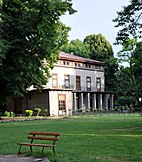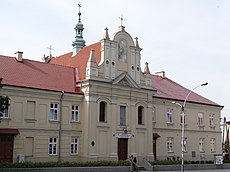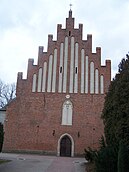Przeworsk
Przeworsk | |
|---|---|
Market Town | |
 Town Hall | |
| Coordinates:50°4′N22°30′E/ 50.067°N 22.500°E | |
| Country | |
| Voivodeship | |
| County | Przeworsk |
| Gmina | Przeworsk(urban gmina) |
| Established | 10th-11th century |
| First mentioned | 1280 |
| Town rights | 1393 |
| Government | |
| • Mayor | Leszek Kisiel |
| Area | |
| • Total | 21.98 km2(8.49 sq mi) |
| Elevation | 200 m (700 ft) |
| Population (2006) | |
| • Total | 15,747 |
| • Density | 720/km2(1,900/sq mi) |
| Time zone | UTC+1(CET) |
| • Summer (DST) | UTC+2(CEST) |
| Postal code | 37–200 |
| Car plates | RPZ |
| Website | www |
Przeworsk(Polish:[ˈpʂɛvɔrsk];Ukrainian:Переворськ,romanized:Perevors'k;Yiddish:פּרשעוואָרסק,romanized:Prshevorsk) is a town in south-easternPolandwith 15,675 inhabitants, as of 2 June 2009.[1]Since 1999 it has been in theSubcarpathian Voivodeship,and is the capital ofPrzeworsk County.The ancientPrzeworsk culturewas named after the town.
Przeworsk was a settlement since the 10th century, though evidence of human settlement in the general area is even older. It is first mentioned in historical records from the 13th century, and was granted its town charter in 1394. From 1772 the town was part of theHabsburg monarchywhere it remained until 1918 when an independent Poland returned. Przeworsk is located onEuropean route E40.It also is an important railway junction, with trains going in three directions – east (towardsPrzemyśl), west (towardsRzeszów) and north (towardsStalowa Wola).
Przeworsk has some 60 historic buildings, including two fortified Gothic abbeys, a town hall, the Lubomirski Palace inclassicalstyle, abaroquemonastery, and an open-air museum (skansen). The town covers an area of 22 square kilometres (8.5 square miles).
History
[edit]Name variations
[edit]In 13th centuryRutheniandocuments, Przeworsk was speltPereworesk.In the 14th and 15th centuries, its name was subject to variation. It was calledPreworsko,Przeworsko,Przeworszko,Przeworscho,Przeiworsko,PrzyworskoandPrziborsko.Since the 15th century, the namePrzeworskowas most often used.
Recorded history
[edit]In the earlyMiddle Ages,a defensivegordexisted there. The area was included in the emerging Polish state by its first historic rulerMieszko Iin the 10th century. In 981 it was annexed from Poland by theKievan Rus',and afterwards, in theHigh Middle Ages,it changed owners several times betweenPolandand the Rus', and even fell to theMongol Empirein the mid-13th century. It was first mentioned in documents from 1280, when, after the Battle of Gozlice (23 February 1280) between Lesser Polish and Ruthenian-Tatar forces, DukeLeszek II the Blackraided theKingdom of Galicia–Volhynia,then vassal of theGolden Horde,capturing and setting alight the city of "Perevoresk"
"Въ лѣт̑ 6789 (1281) Иде Льстько на Лва и взѧ оу него городъ Переворескъ и исъсѣче и люди в нем̑ вси ѿ мала и до велика и город̑ зажьже и поиде назадъ во своӕси"[2]
In the year 6789, (1281) Leszek attackedLeo I of Galicia,and took his city of Perevoresk and killed all in it, sparing neither young or old and having burnt the town to the ground he left.
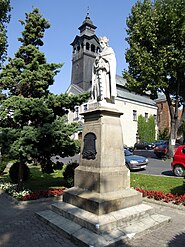
After theGalicia–Volhynia Warsin mid-14th century, this territory of theKingdom of Galicia–Volhynia,was reincorporated to theKingdom of Polandby KingCasimir III the Greatand afterwards transformed into theRuthenian Voivodeshipwithin the largerLesser Poland Province of the Polish Crown.Soon Polish settlers came to the deserted border areas, and in November 1387, KingWładysław II Jagiełłoceded Przeworsk to the Voivode ofSandomierz,Jan of Tarnow,Leliwa coat of arms.Przeworsk grew fast, and on 25 February 1393, Jagiełło granted it a town charter.
Until the 18th century, Przeworsk was aprivate townof severalPolish noblefamilies, as it passed throughTarnowski,OstrogskiandLubomirskiownership. Since 1470, it was the seat of theLand courtfor the western territory ofPrzemyśl Landin the Ruthenian Voivodeship. Przeworsk became the second largest town in the area afterPrzemyśl,prospering in the period known as, thePolish Golden Age.It was situated on a round hill, 212 metres (696 feet)above sea level.Its center was protected by a rampart with a moat. The town hall was built in the 15th century.
SinceCrimean Tatarsoften raided the southeasternPoland,and sometimes even reached its south-central parts, in 1510 the construction oframpartswas started. The defences of Przeworsk consisted of three main elements: a fortified Bernardine monastery in the east, a fortifiedOrder of the Holy Sepulchremonastery in the west, and the town with its three gates in the middle. These fortifications turned out to be inadequate, as both in 1612 and 1624, Przeworsk was captured by the Tatars. Later, the town was captured by the Cossacks (1672, 1677), Swedes (1702) and Russians during theGreat Northern War.On 22/23 March 1656,Charles X Gustav of Swedenspent one night here, during his failed raid on south-central Poland. Przeworsk suffered in several successive fires (1712, 1717, 1739, 1740, 1759). All these events contributed to the town's steep decline.
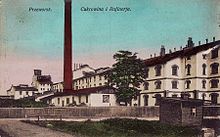
InFirst Partition of Poland,in 1772, Przeworsk was annexed by theHabsburg Empire,remaining in AustrianGaliciauntil November 1918. In the late 18th century, the Austrian authorities pulled down the obsolete late-medieval ramparts and gates. The town remained in decline until the late 19th century, when it became a railway junction, and a center of sugar production, with the Przeworsk Sugar Refinery (1895). In 1859, Przeworsk was connected by rail withKrakówby theGalician Railway of Archduke Charles Louis.In 1902 it had a new railroad toRozwadów,and in 1904, a narrow gauge line toDynówwas completed. The population began to grow, new housing was built, together with a monument dedicated to KingWładysław II Jagiełło(1910), butWorld War Ibrought destruction to the town.
In 1918 Poland regained independence, and in theSecond Polish RepublicPrzeworsk was part ofLwów Voivodeship.In 1929, it became of a county seat and in 1930, several buildings burned down in a fire.
During the joint German-Sovietinvasion of Poland,which startedWorld War II,Germany conducted air raids on 3, 5 and 6 September 1939, in which several people were killed and many were wounded.[3]Przeworsk was captured by theWehrmachton 9 September 1939, and then theEinsatzgruppe Ientered the town to commit variousatrocities against Poles.[4]TheGerman occupationlasted until 27 July 1944. During theIntelligenzaktion,on November 3, 1939, the Germans deceitfully gathered the local Polishintelligentsiafor a formal meeting, then arrested 58 people and imprisoned them inRzeszów.[5]TheJewishcommunity was decimated inGerman extermination camps.
ThePshevorskHasidicdynasty, which originated in Przeworsk, is now mainly located inAntwerp,Belgium.
Tourist attractions
[edit]- Basilica of the Holy Spirit, built in the 15th century with a unique chapel – Tomb of Jesus Christ (the same as inJerusalem)
- GothicChurch of the Bernardine Order
- Palace and park ofLubomirskifamily
- BaroqueDaughters of Charitymonastery and Our Lady of the Snow church
- Gothic defensive town walls
- Monument of Polish KingWładysław II Jagiełłoat theRynek(Market Square)
- The only truly "vivid"open-air museumin Poland, with wooden houses from Przeworsk and the surrounding region.
- The Wąskotorówka Train (narrow gauge railway) going from Przeworsk to Dynów.
- Firefighting Museum
Sport
[edit]The localfootballteam isOrzeł Przeworsk.It competes in the lower leagues.
People associated with Przeworsk
[edit]- Piotr Aigner– architect of the Lubomirski Palace
- Fryderyk Bauman– architect, sculptor and designer of the Lubomirski Palace interiors
- Andrzej Ćwierz– Member of theSejm
- Antoni Lubomirski– founder with his wife,Zofia Lubomirska,of theSisters of St. Vincent de Paulconvent and church
- Zofia Lubomirska– founder of the vast textile and silk factories
- Izabela Maria Lubomirska– princess
- Henryk Ludwik Lubomirski– prince
- Paweł Miesiąc–Motorcycle speedwayrider
- Zygmunt Mycielski– composer andmusicologist
- Tadeusz Rut– athlete
- Andrzej Sztolf–Olympicski-jumper
- Stanisław Żuk – creator of theSkansenMuseum and shepherd
International relations
[edit]Twin towns – Sister cities
[edit]Przeworsk istwinnedwith:
References
[edit]- Notes
- ^"Population. Size and structure by territorial division"(PDF).1995–2009Central Statistical Office00-925 Warsaw, Al. Niepodległości 208. 2 June 2009.Retrieved22 June2009.
{{cite web}}:External link in|publisher= - ^Ruthenian chronicle after the Hypatian list, Galicia-Volhynian chronicle
- ^"Muzeum w Przeworsku wspomina pierwsze dni II wojny światowej".MojPrzeworsk.pl(in Polish).Retrieved28 December2020.
- ^Wardzyńska, Maria (2009).Był rok 1939. Operacja niemieckiej policji bezpieczeństwa w Polsce. Intelligenzaktion(in Polish). Warszawa:IPN.pp. 58–59.
- ^Wardzyńska, p. 257
External links
[edit]- Official website(in Polish)




